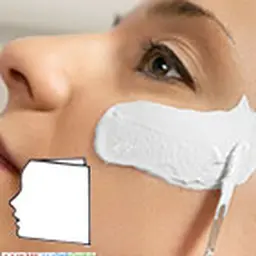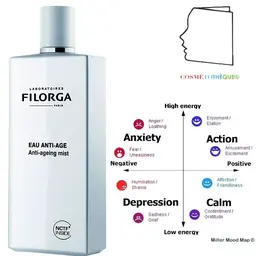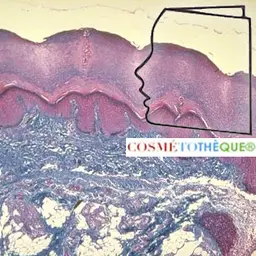
Michelle Vincent invites us to pursue the discovery of clinical research in cosmetics through the work and contributions that have gradually helped to describe the concept of"healthy skin". These approaches have led to important advances for this industry, which until then was only interested in the skin through the ingredients and the formulation. Once the synthesis between skin characteristics and ingredients was made, the development of effective products took on a new look. In this section, Michelle invites us to relive the adventure of skin bioengineering in Besançon. - Jean-Claude Le Joliff
2. The development of measurement systems
The 1930s saw the rise of great cosmetic brands created by women of character such as Helena Rubinstein, Elisabeth Arden, Ella Baché or by the talented chemist Eugène Schueller, whose company became the multinational L'Oréal. At that time, cosmetics was still in a somewhat empirical approach. Scientific measurements of the effect of products on the skin are in their infancy. Little by little, under pressure from industry among others, knowledge of the skin will strongly evolve through the contribution of techniques or means of evaluation which will make it possible to define more precisely the characteristics of the skin, but also to begin to objectively measure the effects of the products. A new era of collaboration between dermatology and cosmetics will open up and offer important avenues for progress.
In the beginning, the impressions
The adventure began with the development of biophysics and cutaneous metrology, following, among others, the work of the Czech dermatologist J. Zahejsky, who proposed a technique for taking impressions to study the microtopography of the surface of the epidermis. The contributions of new chemical and physical equipment and techniques will make it possible to better understand healthy skin and to objectify the effects of products. We are thus moving from a world of allegations to a world of evidence. Great advances in biophysics have led to the clinical evaluation and measurement of the effects of products.
The creation in March 1951 of the Société Française de Cosmétologie (SFC) will contribute to the dissemination of knowledge. But it was not until the late 1970s that skin biometrology really emerged. This is how laboratories will gradually integrate these biophysical devices to investigate the characteristics of healthy skin, hitherto only defined as opposed to pathological skin. A new science will develop around new functions. This will mainly be the contribution of what will later be called the"life sciences". A"new skin" will gradually take shape before our eyes, that of a complex, multi-compartmentalized, multi-functional organ, emitting and receiving, etc.. This notion will gradually replace the older, static notion of a simple envelope of so-called dead cells. As a result, Cosmetology will make significant progress, both in the definition of ingredients and beauty routines.
The purpose of this article is not to make an exhaustive list of all the existing devices, but to relate some initiatives of precursors in their time and perhaps to imagine the future.
A pioneer: Pierre Agache (1927-2003)
Born in Roubaix in 1927, Pierre Agache studied medicine in Lille. Associate Professor in 1965, he took the position of Professor of Dermatology at Besançon in 1969.
In parallel with his medical research activities, Pierre Agache was above all the creator of an original sector of activity: that of functional skin exploration, which he defined as the practical application of knowledge in skin physiology. His work (1980s) focused first on the excretion of sebum, then on the insensitive loss of water, the mechanical properties of the skin, and wound healing. It will also contribute significantly to progress in photobiology.
Some time after his arrival in Besançon, he created the laboratory of cutaneous biology and biophysics. Pierre Agache became passionate about skin bioengineering and contributed strongly to its development, bringing together two specialties that were very distant at the time, Cosmetology and Dermatology.
It is his research in skin biomechanics that will put him at the international forefront in the field of biometrology. After Miami, Cardiff or Philadelphia, it will be in Besançon that the international congress of the skin bioengineering company will hold its work in the 80s. Professor emeritus of dermatology, he created the Laboratory of cutaneous bioengineering within the Department of dermatology and vascular medicine at the University Hospital Centre Saint-Jacques, Besançon. Numerous publications will accompany this adventure and its contribution to several reference works attests to this. Professor Philippe Humbert ensures the continuity of these approaches.
A private-public partnership: CERT
At that time, Professor in dermatology Pierre Agache, then head of the Saint-Jacques hospital centre in Besançon, began to take an interest in cutaneous bioengineering through his research work in virology. He also met François Dalle, Chairman and CEO of the L'Oréal group. This is the beginning of investigations into the skin's relief or elasticity, with the famous twistometer (patented by L'Oréal Research). This device applies torsional torque to the skin and records the forces associated with this deformation. It thus reports on its biomechanical properties. The use of ultrasound will also appear in the world of cosmetology as a non-invasive observation technique. Starting in 1987, Professor Agache directed numerous theses on the study of the skin using physical techniques (such as that of Patrice Bastian, Contribution to the study of skin thickness by ultrasound , 1987). In the 1990s, he really got involved in this new field of research. with numerous publications and the launch of the Pierre Vernier project in Besançon. This new centre will be inaugurated in 2001.
Initially, the Pierre Fabre group, in collaboration with the dermatology department of the Besançon University Hospital and the science UFR, will create a skin biometrology platform. Professor Agache's idea was to associate the applied mechanics laboratory and Professor Jean Mignot's team to this adventure.
Sciences such as tribology (study of surfaces), physico-chemistry, mechanics, optics, computer science will make it possible to explore the skin in the same way as a material, certainly somewhat singular, since it is alive. Life science and materials science, this surprising association will lead to the emergence of nanometrology. Prof. Hassan Zahouani, student of Prof. Agache and Prof. Mignot, will become the specialist of tribology (science of friction) in cosmetics. Alongside Safwat Makki, lecturer at the Faculty of Medicine and Pharmacy of Besançon, specialist in relief and cutaneous absorption (confocal microscopy, profilometry, Franz cells) and member of Professor Humbert's team, he will contribute to the development of knowledge on cutaneous relief.
In parallel, the CNRS tribology and systems dynamics laboratory will file, in 2005, an international patent on a tribo-acoustic probe that measures the elasticity, stiffness and roughness of a contact. We then know how to objectify the softness of the skin, the hair…
In 1993, Professor Philippe Humbert succeeded Professor Agache as head of the Centre d'Études et de Recherche sur le Tégument ( NB : the integument corresponds to the covering tissue of the body, namely the skin, mucous membranes and dander: hair, hair, nails…), CERT, a partner of the Laboratory of Skin Engineering and Biology (LIBC) and the Department of Dermatology of the Besançon University Hospital. This skin expertise centre has a integument characterization laboratory (measurements of physical, anatomical and chemical parameters) and a skin pharmacology platform for pharmacokinetic and pharmacodynamic studies in and on the skin. ex vivo .
For Prof. Philippe Humbert, former President of ISBS (International Society of Biophysics and Imaging of the Skin ), " three periods marked the development of cutaneous biometrology ". - The years 1998-99 with the highlighting of the effect of a cosmetic in vivo . This was the first time that a study showed the stimulating action of vitamin C on collagen synthesis (+ 30%)[1]. - Then 2002 with the arrival of a device to objectively measure skin radiance (light scattering). - Finally 2004 with the pharmacological demonstration of the deficiency of the skin in Vitamin C with age[2].
Since then, a lot has been achieved, with the creation in 2004 of Bioexigence, within the framework of the law on research and innovation, chaired by Doctor in Pharmacy Carol Courderot-Masuyer. This company is specialized in efficiency tests in vitro and percutaneous penetration studies on skin explants. Then in 2006, Skinexigence was born, headed by Dr. Sophie Mac, a company that won the"creation-development" category of the 7th national competition for the creation of innovative technology companies of the Ministry for Higher Education and Research. Skinexigence develops image analysis techniques to extract qualitative and quantitative information, as well as various models (neuronal detection, colorimetric and/or geometric analysis, granulometry, profilometry). Finally, ProviSkin is specialized in the research of skin explant tests and study in vitro and offers a range of patented products: K-Skin skin kit, D-Skin diffusion cell… CERT, a private/public structure, appears as an incubator of innovative startups in the field of skin bioengineering.
" When I arrived at CERT," continues Philippe Humbert,"I recruited many engineers and continued to develop the center by bringing new measurement tools like the ÉclatScope® (in 2002), the first to be able to quantify skin radiance parameters. The other very important axis on which CERT is working is that of its expansion beyond borders. We recently trained five professors of Dermatology and Chinese Medicine who are now our relays in different cities in China (Beijing, Chengdu, Suzhou, Ürümqi). Thailand has asked us s to conduct the same type of research we are doing here in France. CERT also advises companies wishing to develop their own biometrology laboratory such as Silab or GreenTech. ". The craze for biometrology continues, just like the phenomenon Lifelogging, to quantify everything that can be quantified in terms of personal data. This will probably lead to miniaturizing the measurement sensors as much as possible.
At the same time, other universities, such as Paris Sud (pharmacy faculty of Châtenay-Malabry) to name but a few, will contribute to deepening knowledge of the skin through the conduct of numerous theses co-funded by major cosmetic brands.
Meeting between research and industry, creation of SF2iC
 The
Société Francophone d'Ingénierie et d'Imagerie Cutanée
(SF2iC, a non-profit association) was created on December 16, 1999, with the objective of promoting scientific research on non-invasive evaluation methods in skin imaging and skin engineering, developing knowledge in the fields of the functional properties of healthy and/or pathological skin as well as the effectiveness and safety of skin treatments, and encouraging scientific discussion among French-speaking experts. In particular, it organises congresses every two years, alternating with seminars on engineering and skin imaging. The association is managed by a Board of Directors of a maximum of nine persons elected for a period of four years, renewable once at the General Assembly.
The
Société Francophone d'Ingénierie et d'Imagerie Cutanée
(SF2iC, a non-profit association) was created on December 16, 1999, with the objective of promoting scientific research on non-invasive evaluation methods in skin imaging and skin engineering, developing knowledge in the fields of the functional properties of healthy and/or pathological skin as well as the effectiveness and safety of skin treatments, and encouraging scientific discussion among French-speaking experts. In particular, it organises congresses every two years, alternating with seminars on engineering and skin imaging. The association is managed by a Board of Directors of a maximum of nine persons elected for a period of four years, renewable once at the General Assembly.
Over the last thirty years, significant progress has made it possible to better characterize the skin in its various physical (mechanical, optical, tribological, etc.) and physico-chemical components. Research teams from industry, hospitals and universities (CNRS - INSERM) are increasingly interested in these new characterization methods.
2. EVEQUE N, ROBIN S, MAKKI S, MURET P, ROUGIER A, KANTELIP JP, HUMBERT Ph. Iron and ascorbic acid concentrations in human dermis in respect to age and body site. Gerontology 2003, 49 : 117-22.
|
We owe this new contribution to Michelle Vincent with the collaboration of the CERT teams. Special thanks to Philippe Humbert for his contribution and availability.
Michelle Vincent
|

 In 1993, fate led her to a more glamorous universe, that of cosmetics. She joined Chanel in Neuilly sur Seine. In 2008, change of direction for the professional press as editorial director. At the same time, at the end of 2012, she created her consulting firm to assist companies in the development of evaluation methods, cosmetics and scientific content writing. Finally, she teaches at ISIPCA on sustainable development modules, CSR, and the natural sector. She has collaborated with the Cosmetotheque® since its creation.
In 1993, fate led her to a more glamorous universe, that of cosmetics. She joined Chanel in Neuilly sur Seine. In 2008, change of direction for the professional press as editorial director. At the same time, at the end of 2012, she created her consulting firm to assist companies in the development of evaluation methods, cosmetics and scientific content writing. Finally, she teaches at ISIPCA on sustainable development modules, CSR, and the natural sector. She has collaborated with the Cosmetotheque® since its creation.













